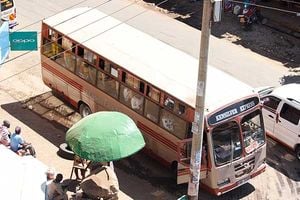New hope for Mau as communities commit to protect forest land

Residents of Teret location, Njoro sub-county Nakuru County carrying tree seedlings for planting at Logman forest on September 25, 2023. Logman forest block is part of the Eastern Mau forest complex.
What you need to know:
- Christopher Kahenya, the chairperson of Logman CFA, said more than 1,800 members are committed to protecting the forest after signing the management plan.
- “We have put in place trained forest scouts to monitor any illegal activities near this resource and that is our commitment,” said Mr Kahenya.
The depleted Mau Forest got a new lease of life when communities neighbouring Eastern Mau Forest block renewed their Participatory Forest Management (PFM) plans for 2023-2027.
The water tower is facing adverse effects due to political instability, unsustainable use levels and patterns as a result of poverty, increasing population, unemployment, and poor management skills and structures.
The agreement plans were signed by the Kenya Forest Service (KFS), Kiptunga and Logman Community Forest Associations (CFAs).
Kiptunga Forest Reserve covering 10,363.2 hectares provides diverse benefits to the local communities in the form of beekeeping, grazing, fuelwood collection, non-resident cultivation, ecotourism, and herbal medicine.
The forest reserve is also the main source of River Mara, which flows into the Mara Basin, River Njoro which drains into Lake Nakuru and Molo River which drains into Lake Baringo, areas that are of great economic importance to the country and globally due to tourism and richness in biodiversity.

Residents of Teret location, Njoro sub-county Nakuru County carrying tree seedlings for planting at Logman forest on September 25, 2023. Logman forest block is part of the Eastern Mau forest complex.
KFS also signed other separate agreements with forest blocks in Bahati, Dundori and Menengai in Nakuru County. The renewal of the plans comes at a time when President William Ruto recently ordered the sacking and prosecution of 23 KFS managers and rangers over corruption and incompetence.
Dr Ruto called on encroachers of Mau Forest and other natural resources across the country to vacate immediately before they are removed. It now remains to be seen whether the implementation of the approved plans by community forest associations will save the larger Mau Forest complex.
In the meantime, the government plans to plant 15 billion trees by 2032, a programme aimed at reaching 30 per cent of tree cover to restore and conserve 10.6 million hectares of degraded landscapes and ecosystems.
Christopher Kahenya, the chairperson of Logman CFA, said more than 1,800 members are committed to protecting the forest after signing the management plan. “We have put in place trained forest scouts to monitor any illegal activities near this resource and that is our commitment,” said Mr Kahenya.
He added: “Since we started working with KFS, we have planted over 600 Ha of exotic tree plantations through the Plantation Establishment and Livelihood Improvement Scheme (PELIS).” PELIS is a governance scheme introduced after the enactment of the Forest Act, 2005 by KFS to help increase forest cover and restore degraded forests in the country.
“PELIS has led to food security and improved the livelihoods and lifestyle of many residents living adjacent to Logman Forest, who were destructive but have changed and they now keep merino sheep while another user group of the forest is earning good money from beekeeping as they sell honey,” said Mr Kahenya.
The official said the CFA has also managed to rehabilitate and restore over 40 Ha of degraded areas where the survival rate of the tree seedlings is over 90 percent. “This is a result of the good cooperation between the CFA and KFS. We’re committed to growing trees in all the degraded areas of Logman Forest,” added Mr Kahenya.
The official said plans were at an advanced stage to sensitise the community on the need to reduce the number of livestock driven to the forest. “We’re looking for help to train our communities to change the traditional spaces of grazing their livestock by adopting modern breeds.
This will help regenerated seedlings from indigenous trees to survive,” said Mr Kahenya. Kiptunga CFA Chairperson Joseph Lesingo said the association members are committed to protecting the 10,363.2 Ha, which include 8,169 Ha of indigenous forest and a plantation area of 1,968 Ha.
“So far we have planted 253 Ha of new plantation and with the signing of the new agreement, this gives us more energy to double our efforts to plant more trees,” said Mr Lesingo. “We’re not taking chances and through the Ogiek People Development Programme, we have recruited 10 forest scouts to keep a close watch on the forest boundaries.”
The CFA has also made good use of 800 beehives donated by various donors including KFS and Kenya Water Towers among others. However, he said cases of colony collapse disorder remain a major challenge and pose a major long-term threat to bees.
“The number of hives that do not survive has substantially increased in the last five years and we urged experts to assist our beekeepers to make a breakthrough in the lucrative honey-making sector,” said Mr Lesingo.
“We also lack honey processing equipment, which we need to move to the next level of vale addition.”
Menengai Forest Association Chairperson Bishop Titus Mugi said his CFA is committed to making Menengai Forest the best ecotourism destination in Kenya.
“We have a natural resource that has a 90km square crater, which is the second largest crater in Africa. We want to make Menengai the most attractive site,” said Bishop Mugi. Bahati CFA Chairperson Peter Mugo said the association covers 7,000 Ha and has over 1,500 members who have been at the forefront of protecting the forest.
“Through the PELIS programme, we have managed to rehabilitate 30 Ha of the forest and reduced greenhouse emissions, stopped and reversed deforestation and restored 5.1 million hectares of deforested and degraded landscapes,” said Mr Mugo.
This is for the purposes of biodiversity conservation, environmental sustainability, sustainable livelihoods and climate resilience. Dundori CFA chairperson Peter Njoroge Nguru said the 3,609.3 ha forest reserve has resources that provide diverse benefits to the local communities in the form of beekeeping, grazing, construction materials, fuel, wood and traditional medicine.
‘‘Our management plan is developed through a participatory process, envisioning a well-managed Dundori Forest Reserve and responsible citizenry for increased ecosystem services and improved livelihood for present and future generations,” said Mr Njoroge.
The Chief Conservator of Forests Alex Lemarkoko said community participation has played an important role to restore the forest to its original state.
“I support them in their endeavour to achieve their vision, which is; “To be the best managed and conserved forest in Kenya in order to enhance community participation in conservation, protection and sustainable utilisation of forest resources for improved livelihoods,” said the KFS boss.





